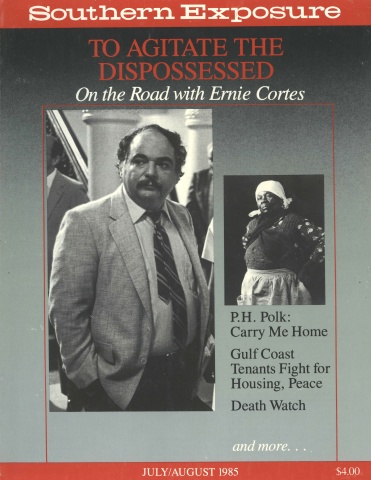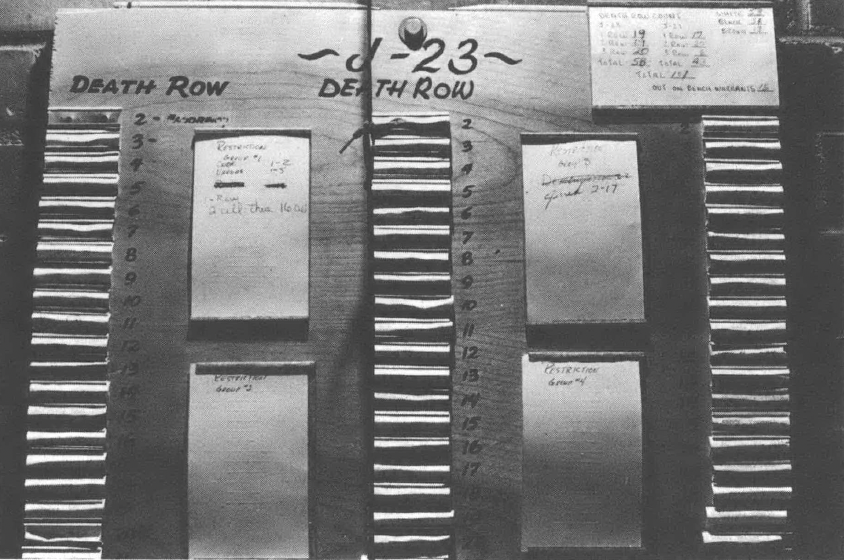
This article originally appeared in Southern Exposure Vol. 13 No. 4, "To Agitate the Dispossessed: On the Road with Ernie Cortes." Find more from that issue here.
The following article contains references to sexual assault.
Through the cool, air-conditioned corridors of the library at the University of Alabama School of Law, stuck behind a door away from everyone and everything, M. Watt Espy, Jr. sits in his cubbyhole, thumbing through his death ledger.
Framed photos of executed criminals cover the walls. There is a snapshot of John Spenkelink, whose execution in Florida in 1979 set off the current wave of executions. There is a picture of an unidentified bailiff holding two of the hanging ropes used in the Jefferson County, Alabama jail. Several other photographs show men strangling at the end of a rope.
Watt Espy, 50, a salesman turned researcher, counts the dead — 14 hours a day, five, six, and sometimes seven days a week. His task is simple in its method, monumental in its impact: to analyze and document every legal execution in U.S. history. His attitude has shifted from ambivalence to steadfast opposition during these 15 years.
When Espy began his task as a hobby, most experts said a project of such magnitude was not possible. At that time, historians and scholars estimated that 7,000 men, women, and children had been judicially executed in this country. At this time, 15 years down a long road of financial sacrifices, of searching old newspapers, tracking local historians and scratching for bits and pieces to so many puzzles, Espy has confirmed 14,500 executions. He expects the count to surpass 22,500 when work is complete.
In 1608 Virginia's George Kendall assured his place in history. Convicted of spying for the Spanish, Kendall was the first man executed in America. Fourteen years later, Daniel Frank followed Kendall to the gallows. His crime: stealing a hog and a cow. Espy explains, "There have been so many executions for horse-stealing, it is pathetic. We know that rape, where the victim was not killed, was a capital offense right up to the 1960s. Burglary of a home or residence where a person slept during the night was a capital offense in virtually every Southern state. Here in Alabama we have an execution for the theft of something valued at a quarter."
Even children have died at the hands of the law. Details are sketchy, but Espy's research shows the youngest person executed was a 12-year-old Indian girl in New Haven, Connecticut in 1786. Two 12-year-old slaves were executed for murder in Virginia in 1787 and 1791.
Espy says, "We have 10 people here in the state of Alabama — out of 681 executed — that we have every reason in the world to believe were innocent. The great proponents of capital punishment will say that's not a bad record at all: we executed 671 guilty people. One of the differences in our form of government and that of a totalitarian system is that we believe it is better that 680 guilty people go free than an innocent one be executed. There is virtually no state in this country — where you've had a number of executions — that didn't execute innocent people."
R. Meade Shumway is but one of many sad examples. Shumway moved from Illinois to Nebraska in 1907 and soon accepted employment on the farm of Mr. and Mrs. Jacob Martin. On September 3, 1907, while Mr. Martin was away on business, his wife was bludgeoned and her throat cut. Shumway was arrested and found guilty of the murder. As Shumway walked to the gallows of the Nebraska State Penitentiary, he told those present, "I am innocent. May God forgive everyone who has said anything against me." Three years later, Jacob Martin, on his deathbed, confessed to the murder of his wife. He expressed remorse for permitting the execution of R. Meade Shumway.
Undiscovered evidence and deathbed confessions are crucial to Espy's findings of innocence. He gathers background on witnesses, accomplices, jurors, judges. He paints a picture that, in most cases, was not available during the trial of the condemned.
Perhaps no other charge has sent as many wrongly convicted men to their death as that of rape. Although rapists were executed in many parts of the United States up until 1965, rape was primarily a Southern capital offense after the early part of the nineteenth century. Blacks were the targets. Of the 455 men executed for rape since 1930, 89 percent were black. Espy points out that no white man has ever been executed in Alabama for raping a black woman, and that only two white men have been executed for rape in that state's history.
"It was the idea we carried here in the South that every black man has wanted to go to bed with our white women," Espy explains. "We've always tended to picture our women as flowery, pure, and if a black man was accused of rape there wasn't much he could do about it. Even if he had an iron-clad alibi, many times the jury would say, 'Well, that's just a bunch of niggers lying to save a bunch of niggers.' It is fairly clear that the death penalty was a racial weapon used by the white power structure and a great number of blacks were systematically eliminated."
Throughout the history of the American death penalty there have been debates over the effects of the punishment on our criminals, our children, our society. "The death penalty," says Espy, "is not a deterrence. I'm convinced of that. Those people that claim it is have never studied it. They've never had the empirical data on which to base their assumptions, and this is the first time that an effort has been made to collect the data upon which accurate assumptions can be made."
In fact, the trend away from public executions began in the nineteenth century as it became evident that the impact of the executions was quite the opposite of the desired sobering effect. The last public hanging in this country was that of Rainey Bethea, a 19-yearold black man who died in Owensboro, Kentucky, in 1936, for the rape and murder of an elderly woman. More than 20,000 spectators gathered to watch. The platform was jammed with dignitaries. Alcohol was in abundance. Many people staggered around, jeering at Bethea. The scene was so repulsive, the criticism so scathing, that the Kentucky legislature banned further public executions.
Espy does not expect public executions to become a reality in the near future, but he is convinced that private ones will continue for quite some time. Inmates, litigating for years, have simply exhausted their appeals. That fact, coupled with the conservative trend sweeping the nation and the judiciary, will lead to increasing numbers of executions.
In July 1983, the United States Supreme Court, acting in the case of Thomas Barefoot, sent a loud and clear message to the nation's condemned: cut the delays. The justices ruled that when an execution is imminent, a federal appeals court may compress the time it usually takes to consider legal claims, give a quick decision, and allow the execution to proceed. "This is going to accelerate many death cases," Espy says. "It could be that if they are going to be executed in the future, they will be killed within a year of their conviction. It's going to be boom-boom, bang-bang, you're dead."
"Not every murderer is going to be executed." He points to the 1982 execution of Texas inmate Charlie Brooks as a prime example of selective prosecution. Brooks is dead, while his accomplice is alive with a few years between him and freedom. "It is selective revenge. You're picking one person to atone for the sins of many."
Some of Espy's most meaningful findings are hidden — even from him — in a morass of compiled data. But this problem may soon be solved. During the summer of 1984, the National Science Foundation awarded the University of Alabama a two-year, $200,000 grant to computerize Espy's extensive research compiled in notebooks and ledgers. A team of six students is now rummaging through the lives of those executed with the hope of uncovering, for the first time, some of the most important findings in capital punishment research.
When the grant money runs out, Espy will again face financial limbo. He is currently paid as a clerk by the law school; his job is to research capital punishment. Prior to the grant, almost all expenses were paid out of his pocket, with a little help from the law school. After the grant runs out, Espy will have to renegotiate with the school and could be dropped because of budget problems.
Despite financial difficulty, Espy is not deterred. "The work will go on," he promises. "The work will go on."
Tags
Richard Blake Dent
Richard Blake Dent is a freelance writer based in Tuscaloosa, Alabama. (1985)

